Tag Archives:from the library

6
JunDaphne du Maurier and the Glass Blowers
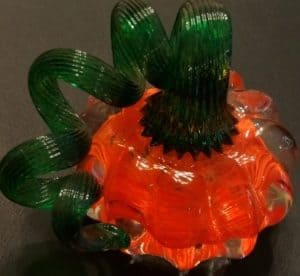 After a recent jaunt to Sandwich, I reflected back on my first trip to “Cape Cod’s Oldest Town” where I visited the famous Glass Museum. There is a large collection of both blown and pressed glass pieces, as well as many artifacts found in the grounds long after the factory was closed. The Museum makes for an interesting few hours, especially if you are a history buff, interested in Cape history, or blown glass – both the history of it and as an art form. The museum also puts on live glass blowing demonstrations, and these alone are well worth the trip. In fact, on Friday, July 19th, the Sandwich Glass Museum will be participating in the 2019 “Free Fun Fridays.” Admission is free for everyone! Check out their website at sandwichglassmuseum.org for more information.
After a recent jaunt to Sandwich, I reflected back on my first trip to “Cape Cod’s Oldest Town” where I visited the famous Glass Museum. There is a large collection of both blown and pressed glass pieces, as well as many artifacts found in the grounds long after the factory was closed. The Museum makes for an interesting few hours, especially if you are a history buff, interested in Cape history, or blown glass – both the history of it and as an art form. The museum also puts on live glass blowing demonstrations, and these alone are well worth the trip. In fact, on Friday, July 19th, the Sandwich Glass Museum will be participating in the 2019 “Free Fun Fridays.” Admission is free for everyone! Check out their website at sandwichglassmuseum.org for more information.
I had first seen glass blown at Greenfield Village at the Henry Ford Museum in Dearborn, Michigan, in the 1980’s. That was a wonderful first introduction to glass blowing. The artist first heated the glass up to a temperature of about 2000 degrees Fahrenheit, where it turned into molten (basically liquid) glass. To make the process even trickier, the glass blower had to work fairly quickly, as the glass needed to remain at a temperature of at least 1400 degrees Fahrenheit in order to remain pliable. I was soon lost in the swirl of glass colors, deft movements, and the excitement (Will he drop it? Will he burn himself?). I was truly fascinated by the entire experience. (See this glass blowing video.)
Knowing about my interest in glass blowing, my friend surprised me last October with a three hour glass blowing class at the Luke Adams Glass Blowing Studio right here in Norwood. We listened as the instructor explained all the tools and techniques, and showed us examples. We were able to jump in and design our own two items. I chose to make a glass and a pumpkin paperweight. I can tell you, the instructors make it look sooooo easy! The tools felt awkward and I was always aware of the heat. I didn’t give the glass quite enough air though, because it was squatter and much thicker than I intended. I had much better luck with the pumpkin, and that was done with a lot of support from the instructor, but it came out beautifully. The point is that I was able to experience glass blowing close up, to feel the tools in my hands and the heat on my face as I worked the glass. The three hours flew by! If I hadn’t already had an appreciation for this art form, I certainly did now.
Not long after I took this class, I was intrigued to see The Glass Blowers by one of my favorite authors, Dame Daphne Du Maurier. Like her more famous books such as Rebecca, Jamaica Inn, and her short story, The Birds, The Glass Blowers presents its own mixture of drama and tragedy as Du Maurier writes about glass blowing during the French Revolution. Even more intriguing, this is a semi-autobiographical historical fiction novel based on Du Maurier’s glass blowing predecessors of La Brulonnerie , Cherigny, La Pierre, and the Chesne-Bidault. Du Maurier uses the settings and characters of The Glass Blowers to tell the story of her own family, with all the accompanying unrest of the French Revolution and family pathos. This novel captures the spirit of glass blowing and shows the close community and family ties that grew in the midst of this specialized art form.
The story opens with Madame Sophie Duval, daughter of a glass blowing master and also the widow of one, meeting her nephew for the first time. Her brother, Robert Busson, had emigrated from France to England with his new wife, abandoning the glass house, his family, and his country due to poor financial decisions and threatened imprisonment. Robert eventually abandons England and his family and returns to his native France to die.
Robert’s son, Jacques, was brought up to believe that his French relatives were of the wealthy upper class, and that the family home was a beautiful chateau. Sophie quickly disabused him of these ideas, remarking that the family home was “no more than a farmhouse.” The rest of the novel portrays Sophie as she gives her long-lost nephew the true story of the Busson glass blowers. Sophie tells him, “A glass-blower, remember, breathes life into a vessel, giving it shape and form and sometimes beauty; but he can, with that same breath, shatter and destroy it.” Sophie unravels the story of her family from before the French Revolution to the five decades after it. Sophie’s quote exemplifies her brother Robert’s life, and the pain he caused his family with his unfortunate decisions.
I am a big fan of historical fiction as a genre, and can appreciate how Du Maurier takes it a step beyond by adding her personal touch. Du Maurier’s descriptions of the glass factory, her in-depth knowledge of the business of glass blowing and the personalities behind them make for a very satisfying and informative read.
Carla Howard is Senior Circulation and Media & Marketing Assistant at the Morrill Memorial Library in Norwood, MA. Look for her article in the June 6, 2019 issue of the Transcript & Bulletin.
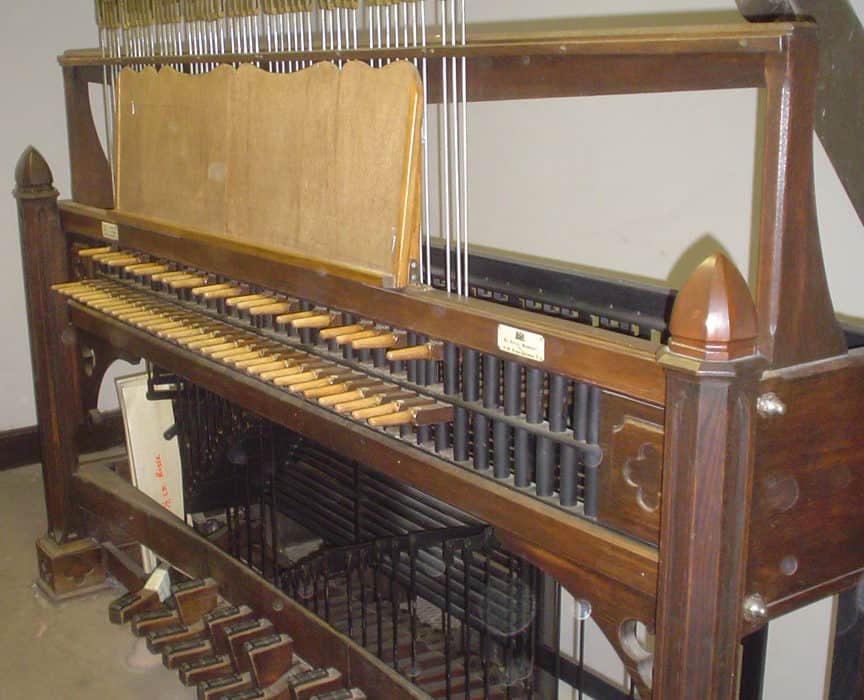
30
MayBells Will Be Ringing
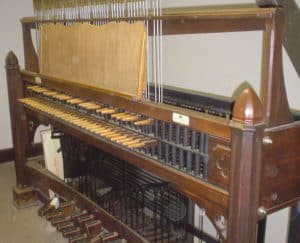
Photo: Lee Leach
One of the many things I didn’t realize about Norwood before moving here is that we have the Walter F. Tilton Memorial Carillon at Town Hall. My undergraduate alma mater also has a carillon which I always enjoyed hearing, so I was excited the first time I heard bells here. I don’t remember the specifics but I suspect I was stopped at the light on Nahatan and Washington and figured the tower was at one of the churches on the Norwood Common since municipal carillons are not very common in the United States. Eventually I discovered it’s in Town Hall and try to listen for at least a few minutes whenever I hear the bells.
Our current Town Carillonneur, Lee Leach, is a frequent library user and at some point the topic of Norwood’s carillon came up in conversation. I told him how much I enjoy hearing the bells and that I am always reminded of my college days. The carillon world is fairly small; there are fewer than a dozen carillons in Massachusetts, so Leach knows the current carillonneur at my alma mater. Not only does she usually participate in the summer concert series, she also brings students to play at Norwood a few times a year. Earlier this winter I was lucky enough to go up in the tower and see/hear some Wellesley College students practicing.
I confess that although I liked hearing the bells on campus I never went up to see the carillon and knew nothing about how the instrument is played. Based on the variety of musical styles I heard, I knew they weren’t ringing the bells by pulling ropes, but beyond that I’m not sure I gave it much thought. For me, seeing the bells and learning how the instrument is played was more interesting than the view. I’ve since done quite a bit of research on the Walter F. Tilton Memorial Carillon, and carillons in general.
A carillon is defined as a musical instrument with at least 23 bells, and is usually in a tower or belfry – anything less than 23 is a chime. Norwood’s carillon has 50 bells as part of the instrument and a 51st bell, which is an old fire bell from Norwood. The carillon is played using a keyboard, or clavier, and pedal board. There are batons rather than keys and the player hits them with the side of his/her fist rather than the finger. Like an organ, there are many more pedals than on a piano. The bells are hung from a frame above the clavier and a series of wires with springs connect to the bell clappers. Striking a baton or pedal makes the wires move the clappers and sound is produced. The clavier can be open to the bell tower or in an enclosed space. Pipe organs are the instrument most similar to a carillon and organ pipes are the only instrument heavier than the largest carillon bells. The Walter F. Tilton Memorial Carillon’s largest, or Bourdon, bell is 71 inches in diameter and weighs 7,840 lbs., it sounds B-flat. Its smallest bell is 6.5 inches in diameter and weighs 11 lbs. Although there is music written for the carillon, many players rework other music for the carillon, including jazz and rock.
Tuned carillons became common during the 1600s in the Benelux countries in Europe, primarily in Belgium and the Netherlands. They were more often found in municipal buildings than in churches. In Singing Bronze: a History of Carillon Music, Luc Rombouts examines why Belgium and the Netherlands were centers of early carillon excellence. He argues that the weaving superiority of the region made it easier for them to create the wire components of the carillon. Reading that made me realize a weaving loom was exactly what the network of wires I’d seen running between the bells and keyboard reminded me of.
The skill of casting tuned bells came close to dying out, but by the turn of the twentieth-century the art had been revived. Before World War I there were fewer than half a dozen carillons in the United States. After the war, many Americans soldiers who heard them for the first time while fighting in Belgium and France felt that carillons were a fitting component of war memorials. Two English foundries: John Taylor and Co., and Gillett & Johnston cornered the American market.
The first municipal carillon in the United States was in Albany, New York’s City Hall. It was cast and installed in 1927 by John Taylor and Co. That company also cast the first carillon in Massachusetts at Our Lady of Good Voyage Church in Gloucester in 1922. The Walter F. Tilton Memorial Carillon is one of three carillons in Massachusetts made by the other significant English foundry, Gillett & Johnston. The Bancroft Memorial Carillon at St. Stephen’s Episcopal Church in Cohasset, dedicated in 1925, was Gillett and Johnston’s third carillon. Norwood’s carillon, dedicated November 11, 1928, was their eighteenth, and Wellesley College’s Galen L. Stone Tower in 1931 was their 34th. More than 30 carillons in less than 10 years made for a busy place – fourteen of those were installed in the United States. England’s Child: the Carillon and the Casting of Big Bells, by Jill Johnston is part biography of Cyril F. Johnston, part corporate history of Gillett & Johnston, and part memoir. Johnston was the child of Cyril F. Johnston and an American nurse who did not learn her father’s identity until after his death.
The Walter F. Tilton Memorial Carillon stopped being played in the late 1970s due to a need for repairs. Once work was begun, it was discovered the entire tower was seriously damaged by water leaks, and repairing the tower and fixing the leaks took precedence. By late 1982, work on the tower itself was nearing completion and the bells could be rehung. In early 1983, the expert hired to evaluate the needed work on the bells discovered that the second and eleventh bells were missing. With all the work that had been in done the tower there was no way to know when or how the bells disappeared. John Taylor, Ltd. of England was the foundry hired to repair and remount the bells. They cast replacements for the two missing bells.
Norwood’s first carillonneur was Kamiel LeFevere, a Belgian who came to the United States to play carillons. He was the first to play at St. Stephen’s in Cohasset and became the carillonneur at Riverside Church in New York City. LeFevere traveled to Norwood to play until 1934. His inaugural performance at the dedication of Norwood’s Town Hall and Carillon was broadcast on radio station WEEI. Roger Walker was the second carillonneur, playing from 1934 until 1972. He lived in Hyde Park, MA so had a much shorter commute for his performances. Martin Gilman played after Walker. George Mahoney, Jr. overlapped with Walker and Gilman. Sally Slade Warner was the carillonneur at St. Stephen’s in Cohasset and also played in Norwood. She managed the summer concert series for many years. Our current carillonneur, Lee Leach heard the Walter F. Tilton Memorial Carillon being played not long after he moved to Norwood in the 1990s. He decided to learn how to play the carillon and has been playing here since 1996. Before Leach, George Mahoney, Jr. was the only Norwood resident to play the Norwood carillon. Leach and Assistant Town Manager Bernie Cooper oversee the carillon. It is a volunteer position for Leach who coordinates the summer concert series, holiday performances and other special events, in addition to playing. There is now another Norwood resident and a few other regular players who are all volunteers.
The 2019 Summer Concert Series kicks off on Monday, June 24 at 7 pm and runs weekly until August 12. If Monday nights don’t work for you, Leach often plays during the farmers’ market on Tuesday afternoons. There will also be a concert on July 4th at 3 pm. The tower is generally open for visitors during or after performances for anyone who is curious to see the instrument. The library will be hosting “Meet the Carillonneurs” on Thursday, June 27 at 6:30 pm with Lee Leach and others who play the Walter F. Tilton Memorial Carillon.
If you have a third grader this year, s/he may go up in the carillon on their field trip to Town Hall. For youngsters who haven’t been up to the carillon, Rosie Meets the Carillon, by Kerri Lu is a story about a little girl whose grandmother plays.
Victoria Andrilenas is a Part-time Adult Services Librarian at the Morrill Memorial Library. Look for her article in the May 30, 2019 issue of the Norwood Transcript.

23
MayCause for Celebration?
 I was listening to the radio a while back when the DJ mentioned National Pizza Day. “Malarkey!” I said (or something like that.) Sure enough, when I did a Google search for national days, I found National Pizza Day listed on nationaldaycalendar.com. This is not to be confused with National Pizza Party Day (May 17.) Of course a little overlap is to be expected on a site that’s now tracking 1,500 national days, and where anyone can fill out a form to register a special day for annual recognition. I was relieved to see that the site doesn’t declare national days for individuals, since that literally requires an act of Congress.
I was listening to the radio a while back when the DJ mentioned National Pizza Day. “Malarkey!” I said (or something like that.) Sure enough, when I did a Google search for national days, I found National Pizza Day listed on nationaldaycalendar.com. This is not to be confused with National Pizza Party Day (May 17.) Of course a little overlap is to be expected on a site that’s now tracking 1,500 national days, and where anyone can fill out a form to register a special day for annual recognition. I was relieved to see that the site doesn’t declare national days for individuals, since that literally requires an act of Congress.
My feelings about acknowledging every day as a special day mirror my philosophy about doling out awards to everyone who participates in an event: if everyone is a winner, then no one is. If every day was ‘special’ we would burn ourselves out in a frenzy of celebration, and start looking forward to doing nothing. Plus, too many days spent overindulging and our pants would no longer fit. Don’t forget how you feel every year by January 1st! That said, I do have a soft spot for certain recently invented national days. May 4th as Star Wars Day appeals to the punster in me (“May the fourth be with you,”) while March 14th as National Pi Day, for the mathematical constant that begins 3.14, appeals to my inner geek. It also appeals to my stomach, since it’s a great excuse to eat the homonymous dessert: pie. Still, I am more of a traditionalist when it comes to holidays. Beyond our ten federal holidays such as Independence Day, and national observances like Mother’s Day, I was curious to learn more about the days we celebrated before the recent proliferation of national days. A search in the Minuteman Library Network unearthed several interesting volumes.
I learned that while it is tempting to think of nouveau holidays as a trend-driven by social media, the reality is that our penchant for partying predates widespread use of the Internet. Alice van Straalen’s The Book of Holidays Around the World (published in 1986) is a charming compendium that boasts “at least one reason to celebrate on every day of the year.” As promised, it includes international celebrations from Norway’s Constitution Day (May 17) to the Chinese Hungry Ghosts Festival (August 18), in which people make offerings of food, money, clothing and such to their ancestors. The layout of this book provides one occasion to celebrate per calendar day, so some of the reasons are a bit thin. Numerous entries rely on famous author birthdays. Nevertheless, there’s not a whiff of National Donut Day or the other stuff trending now.
Anyone who objects to the questioning of author birthdays as a reason to celebrate will likely adore A Reader’s Book of Days: True Tales from the Lives and Works of Writers for Every Day of the Year, by Tom Nissley. True to its title, this book offers a full page dedicated to each day of the year including author birthdays and death dates as well as other reasons to celebrate, or lament. Readers can rejoice in the publication of various works, from the first volume of Cervantes’ Don Quixote (January 16, 1605) to The Hitchhiker’s Guide to the Galaxy by Douglas Adams (October 12, 1979.) Or they can bow their heads over the misfortunes therein such as Ernest Hemingway’s various accidents and injuries, which are detailed across nine different dates! Births, deaths and other goings-on of fictional characters are also included. As an added bonus, Nissley thoughtfully introduces each month with a page of recommended reading.
As well as offering ideas for adding your own flair to holidays, The Book of New Family Traditions: How to Create Great Rituals for Holidays and Everyday by Meg Cox encourages finding new reasons to celebrate. In keeping with the other titles, it suggests celebrating author A.A. Milne’s birthday. It is, this book notes, important to personalize reading by having a sense of the author who created the characters we love. That, and “mid-January is a good time for a party, deep in the winter doldrums.” I have to admit that reading Milne at an indoor picnic with characters from the Hundred Acre Wood while munching on snacks made with honey sounds like a fine idea.
If we needed any further proof that people like to party, Anthony Aveni’s The Book of the Year: A Brief History of Seasonal Holidays offers insight into the origins of celebrations throughout the year. From “Happy New Year! But Why Now?” to “Christmas: From Resurrection to Rudolph,” Aveni progresses through the year offering a broad array of cultural perspectives. Of the origins of Labor Day, he writes that in 1882, “Defying authority, ten thousand men left their jobs and paraded up Manhattan’s Fifth Avenue…” They apparently then had a picnic and rounded out the day with fireworks. It was such a hit that they kept repeating it, until it was formally established as a holiday.
So it would appear that we’ve been drumming up excuses to celebrate for a long time. In spite of my protestations that I’m a purist, and although I balked at the gambit of National Pizza Day, even I could not resist the excuse to celebrate with a slice of Sicilian on February 9th. I guess that’s what bothers me: the fabrication of special days as excuses to indulge somehow diminishes the celebrating we do on days of real import. I love birthday cake but if I ate it every day it would be less special. Yet viewing each and every day as a cause for celebration isn’t an inherently bad idea. I just hope that we can balance out all of the hedonism with a bit of temperance (it will make those indulgences even tastier!) In the meantime, maybe we can celebrate with a little altruism. National Random Acts of Kindness Day, anyone? Technically it’s February 17th, but there’s an idea worth celebrating every day.
Kirstie David is the Literacy/Outreach Librarian at the Morrill Memorial Library in Norwood, MA. Look for her article in the May 23, 2019 issue of the Norwood Transcript.

16
MayFrida Kahlo: Constructing a Life
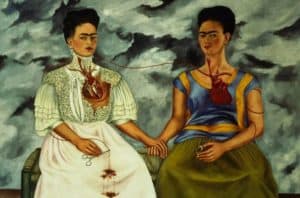 This past weekend was Mother’s Day, or as it is known in our house, the one day of the year my family has to accompany me to an art museum. I chose to go to the Museum of Fine Arts (MFA) in Boston, which is showing an exhibit through June 16th entitled Frida Kahlo and Arte Popular. (The “Arte Popular” refers to traditional Mexican folk art, which Kahlo collected and surrounded herself with.) The exhibit combines Kahlo’s own art with the arte popular that she loved, and asks viewers to consider how these objects impacted her art and aesthetic.
This past weekend was Mother’s Day, or as it is known in our house, the one day of the year my family has to accompany me to an art museum. I chose to go to the Museum of Fine Arts (MFA) in Boston, which is showing an exhibit through June 16th entitled Frida Kahlo and Arte Popular. (The “Arte Popular” refers to traditional Mexican folk art, which Kahlo collected and surrounded herself with.) The exhibit combines Kahlo’s own art with the arte popular that she loved, and asks viewers to consider how these objects impacted her art and aesthetic.
Frida Kahlo is one of the most celebrated artists of the 20th century. She has joined the ranks of Van Gogh and Picasso among others, who are so ubiquitous you don’t even have to know much about art to know who they are. Her work is on a $10 poster in some kid’s dorm room, as well as t-shirts, handbags, toys, and even lipstick. She is no longer just a famous artist, she is pop culture.
Because of this popularity, it can be tempting to dismiss Frida. To say she had a major impact on me seems almost embarrassing; I might as well say “I like art.” Everyone likes Frida, and I tend to be pretty uncomfortable liking something that is extremely popular. If it is everywhere, it becomes less interesting. But of course, this is completely ridiculous – Frida Kahlo is beloved for a reason. Her art is extremely personal. It can be brutal and violent, showcasing her distress for all to see. She is beautiful and powerful; she is pain and beauty. Almost every female artist admires her.
One of the interesting things about Frida is that we don’t just love her art, we love her. We know who she is and what she looks like just as much as we know her painting The Two Fridas. This was intentional and by her design. Her husband, Diego Rivera, was already a famous Mexican painter when her art was recognized and began showing, and she knew what journalists and collectors thought of an artist could be as influential as their work itself (if not more.) So she constructed Frida “the artist” – the face she wanted the world to see.
As a child, her family changed her birth year from 1907 to 1910 to hide the fact that she was developmentally behind when she was entering school, due to illness. As an adult, she kept the 1910 birth year not because she wanted to be seen as younger, but because that was the year of the Mexican Revolution. As a young woman, Frida defied convention and dressed as a man in tailored suits and with short hair. But later, she would commission seamstresses to create elaborate copies of traditional folk dresses that she was sure to be photographed in. She wanted to be seen as a symbol of Mexico, a woman of the people. She would be the embodiment of the strong Mexican Revolutionary.
When Frida Kahlo is talked about, the conversation usually centers around both how personal her art is and how tragic her life was. She poured all of her hopes and sorrows into her art, and pushed the boundaries of how brutal and honest she could be. We look at her work and feel like we know her because she is seemingly showing us pieces of her very soul.
But the MFA show is a little different – a little left of center. We know Frida, but we also know what Frida wanted us to see. She constructed the image of herself with careful thought and planning. Some may see that as a lie – a mask, and feel like we have somehow been cheated out of knowing who she really was.
I like to think a little more hopefully about it. Frida could not help illness and accidents, betrayals and loss. But she surrounded herself with the things she admired and loved. She was a strong, intelligent woman who made herself into the symbol she wanted to show the world. Frida’s work continues to show us that we cannot avoid pain, but we can mold it into something beautiful.
Reading List:
Frida Kahlo: An Illustrated Life by Maria Hesse
Frida: A Biography of Frida Kahlo by Hayden Herrera
The Diary of Frida Kahlo: An Intimate Portrait
Frida Kahlo: The Paintings by Hayden Herrera
Frida Kahlo at Home by Suzanne Barbezat
Nicole Guerra-Coon is the Assistant Children’s Librarian at the Morrill Memorial Library in Norwood, MA.
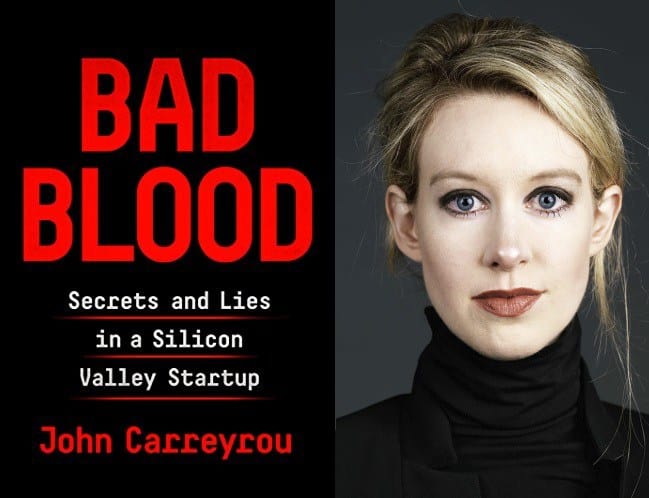
11
MayTheranos, Silicon Valley and Secrets and Lies
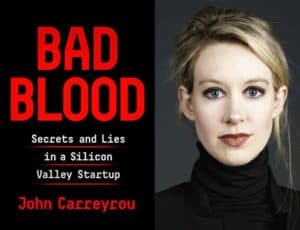 The saga of Elizabeth Holmes and Theranos, her revolutionary (but failed) blood testing company, is a captivating one. While you may have read about it on the Internet, or in news reports last summer, you should read the exposé, Bad Blood by John Carreyrou, published last fall. It is rich with the full account as it was revealed. Carreyrou was (and is) a reporter for the Wall Street Journal. He was hungry for his next new journalistic journey, and a tip about Theranos was just the ticket.
The saga of Elizabeth Holmes and Theranos, her revolutionary (but failed) blood testing company, is a captivating one. While you may have read about it on the Internet, or in news reports last summer, you should read the exposé, Bad Blood by John Carreyrou, published last fall. It is rich with the full account as it was revealed. Carreyrou was (and is) a reporter for the Wall Street Journal. He was hungry for his next new journalistic journey, and a tip about Theranos was just the ticket.
The story of Theranos begins with Elizabeth at 19 – a college dropout – and a concept that depended on all the stars aligning and the pieces of the puzzle falling into place. Most importantly, however, science was required to work.
Detractors have declared that the science was never there to begin with. That it was an absurd quest. Others question if more years and engineering may develop the product that Elizabeth promised – a piece of medical equipment that can deliver accurate results of over 1000 separate tests using only a finger-prick and one drop of blood. Theranos bombed miserably, but not before duping investors and the public.
For those of us hungry for a tragic tale – one that includes billions of dollars and an abundance of Silicon Valley garish living habits, the story does not disappoint. And further, there are continuing acts of trickery, meaningless investments, and the clandestine romance of the two ambitious, vital players.
If you are further intrigued, the HBO documentary, The Inventor: Out for Blood, is an excellent way to watch Elizabeth Holmes in action. It is full of both stills and video that explain some of Elizabeth’s appeal. More importantly, the documentary is full of interviews and testimonies with the whistle-blowers, the detractors, and some of the people who finally began to suspect that Theranos was essentially a house of cards ready to fall. (The HBO documentary is available in several outlets; I found it offered free on a JetBlue flight. Be assured that we will purchase the documentary when it is available on DVD.) Some of Holmes’ charm (whether you find her alluring or not) is explained in the video; at least it is obvious by the men who were beset with her.)
Another, somewhat abridged version of the story is the fascinating six-episode (free) podcast, The Dropout (produced by ABC Radio and ABC News Nightline.) It’s under five hours of listening and rich with the voices involved in the scandal. I listened to the podcast before reading the book; the book is a richer telling of the Theranos tale. I described the podcast as abridged because there are details in Carreyrou’s book that answered many of the questions I had that were left unanswered by the podcast.
The documentary and the podcast left me wanting more. There are hundreds of news articles written about Theranos, both in the ascent of Elizabeth Holmes and in her tragic downfall. In addition, there are short videos and teasers for the documentary.
Many people can’t wrap their head around the magic spell Elizabeth Holmes presented or staged to enchant men like statesmen George Shultz and Henry Kissinger, investors like the Walton (Walmart) family, Rupert Murdock, and Betsy DeVos, and business partners like Walgreen’s. But she did. And easily. They were all hopelessly smitten by the young woman, or by the recommendations of people in high places. For a period of 14 years, Holmes managed to defraud millions of dollars in investments for her Silicon Valley start-up, much of it from Walgreen’s, the pharmacy “trusted since 1901.”
Some of Elizabeth Holmes’ biographical history explains her rise to fame. She was smart. She was pretty. She was ambitious. As a young child, Elizabeth was attracted to both fame and fortune, and she dreamed of becoming recognized for inventing something that would change the world. Some have suggested that her biggest aspiration was to become a billionaire.
Those who interacted with Elizabeth in the classroom or neighborhoods she lived in seemed to be either dazzled or unimpressed by Elizabeth’s poise, composure, and can-do attitude. She was enabled by a family who encouraged her and who had some critical connections through their work and lifestyle. She lived in both Washington, DC and Houston and was afforded splendid opportunities such as summer Mandarin language programs in China. She had no difficulty being accepted to Stanford as a freshman in 2002. By 2004, at the age of nineteen, she dropped out of college, mainly because she was spending more time presenting her ideas to venture capitalists and to influential contacts and wealthy families than she was spending on her studies.
Elizabeth amazingly succeeded in getting her advisor and the Dean of the School of Engineering, Channing Robertson, to join her in her effort to “revolutionize healthcare.” Other influential men in the heart of Silicon Valley, particularly with ties to big money were also impressed, and they all helped her in her spectacular rise. Of note, however, is that none of the investors and board members influential in Holmes’ rise were engineers or scientists. Just like those who knew her as a child, not everyone was charmed with Elizabeth or her company. She had detractors along the way. Many Silicon Valley stars quickly left her company, and some became whistle-blowers. One became so disheartened that he took his own life.
The story of Theranos is actually ongoing, even though the company ceased to exist in 2018 after a three-year investigation by the SEC and others. Elizabeth, the woman who yearned to be the next Steve Jobs, is facing criminal charges of up to 20 years in jail, along with her one-time lover, Ramesh (Sunny) Balwani. The real tragic end may come later this summer after the trial is over.
Charlotte Canelli is the Director of the Morrill Memorial Library in Norwood, MA. Look for her article in the May 9th issue of the Norwood Transcript.
